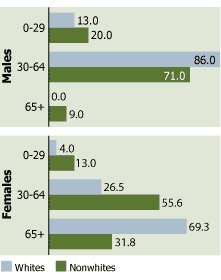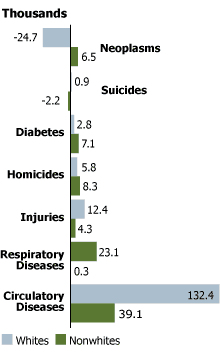
Why Do Canadians Outlive Americans?
This article is adapted with permission from Barbara Boyle Torrey and Carl Haub’s article “A Comparison of U.S. and Canadian Mortality in 1998,” Population and Development Review 30, no. 3 (2004).
(November 2004) Over 250,000 Americans who died in 1998—roughly one of every ten U.S. deaths that year—would have survived had they been Canadian, according to a comparison of patterns of death between the two countries.
And such “excess deaths” in the United States have been growing in number for over 40 years. In 1955, Americans and Canadians had almost the same life expectancy at birth. In 1998, however, life expectancy at birth was 76.7 years in the United States and 78.8 years in its northern neighbor—a notable divergence at a time when life expectancy among high-income countries was tending to converge.1
Why do Americans die an average of 2.1 years earlier than Canadians? Using basic mortality data for the two countries for 1998, we find that obesity appears to be a major suspect in the disparities.
Canada and the United States: A Natural Comparison
Canada and the United States resemble each other more than they do any other country. They share a language, a continent, and a border. They are also both younger than their European allies, have resource-based economies, and are two of the wealthiest countries in the world. These similarities create a natural opportunity to study why the two countries differ so much in both life expectancy and death rates.
We calculate the numbers of deaths by age and sex that would have occurred in the United States on the assumption that Canadian mortality rates prevailed in the 1998 U.S. population.2 We use seven broad categories of cause of death (neoplasm, suicide, diabetes, homicide, injury, respiratory diseases, and circulatory diseases) developed by the International Classification of Diseases (ICD). In 1998, these causes accounted for 84 percent of all U.S. deaths.
Figure 1
Percent Distribution of Excess U.S. Deaths Relative to Canada by Sex and Race for Three Age Groups, 1998

Source: U.S. Census Bureau, unpublished file NESTV 98; National Center for Health Statistics, “Death Rates for 282 Selected Causes by 5-Year Age Groups, Race and Sex: United States 1979–1998”; and Statistics Canada, Mortality—1998 Shelf Tables.
Figure 2
Excess U.S. Deaths Relative to Canada by Cause of Death: Both Sexes, Whites, and Nonwhites, 1998

Source: U.S. Census Bureau, unpublished file NESTV 98; National Center for Health Statistics, “Death Rates for 282 Selected Causes by 5-Year Age Groups, Race and Sex: United States 1979–1998”; and Statistics Canada, Mortality—1998 Shelf Tables.
By our calculations, the United States in 1998 had 253,237 excess deaths as compared with Canada—11 percent of all deaths in the U.S. that year.3 In absolute terms, excess American deaths relative to Canadian deaths were most prominent among middle-aged men and among older women (see Figure 1).
Since Canadian mortality rates are not disaggregated by ethnic or racial groups, we also compared death rates for the total Canadian population with American white and nonwhite death rates. In proportionate terms, 35 percent of all excess U.S. deaths occurred to nonwhites, a percentage twice as high as the share of nonwhites in the U.S. population in 1998. But even among the more homogenous white American population alone, there were 164,756 excess deaths in 1998 as compared with Canadians.
Three Major Suspects: Smoking, Hypertension, and Obesity
We found excess American deaths relative to Canadian deaths in five of the seven ICD categories (see Figure 2). One of these categories—circulatory diseases—constitutes the most important cause of death in both Canada and the United States and accounts for 68 percent of all American excess deaths.
Circulatory diseases—which include 34 separate conditions, including hypertensive diseases and congestive heart failure—were the cause of 95 percent of the excess deaths of all U.S. women over age 65 and also were the largest single category of deaths among men and women under age 65.
Since circulatory diseases are such a large proportion of excess deaths in the United States, we focused on the major behavioral risk factors for many of these diseases: smoking, hypertension, and obesity.4
A number of surveys over the years have measured the prevalence of smoking in Canada and the United States.5 But while the differences in smoking rates between the two countries are today not very great, Canada has historically had higher levels of smoking—suggesting that this behavior is not an important factor in the excess U.S. deaths from circulatory and other diseases.
As for hypertension, a recent study found similar prevalence in both countries—21.1 percent of all Canadians age 18 and older have the disease, versus 20.1 percent in the United States.6 But the study also found that a higher percentage of Canadians with hypertension go untreated for the condition, and that more Canadians (43 percent) are unaware of their hypertension than their U.S. counterparts (at 30 percent). Therefore, hypertension also cannot account for the excess American deaths.
And the percentage of “overweight” individuals—defined as having a Body Mass Index (BMI) over 25—has increased in both countries since 1970s. The most recent comparative data suggest that the prevalence of Canadian males with BMIs between 25 and 29.9 (at 44 percent) was actually higher than that of U.S. males (at 40 percent), and that the percentage of Canadian women in this BMI range was slightly lower than that of American women.
The Dead Weight of Obesity?
But comparisons of obesity rates between the two countries (with obesity defined as a BMI over 30) tell a sharply different story. In 1998, American men were twice as obese as Canadian men (28 percent of the total U.S. male population versus 13 percent for Canada). American women were three times as obese as Canadian women (34 percent versus 11 percent). Recent estimates of remaining life expectancy for people who are overweight and obese suggest that the consequences of these conditions are substantial.
And a 40-year follow-up of the famous community health study of Framingham, Mass. reported that life expectancy at age 40 there was reduced because of excess weight.7 The findings suggest that obesity can account for much of the 1.5-year difference in life expectancy between Canadian and American women at age 40 and more than half of the 1.3-year difference between Canadian and American men.
While a number of other factors—such as disparities in health care coverage—may be important in explaining the differences in death rates between Canadians and Americans, this analysis provides an important perspective on our own mortality. The comparisons of data on mortality and risk factors in Canada and the United States reinforce the validity of widely expressed concerns over obesity.
Barbara Boyle Torrey is a visiting scholar at PRB. Carl Haub is senior demographer and holds the Conrad Taeuber Chair of Public Information at PRB.
References
- Kevin M. White, “Longevity Advances in High-Income Countries, 1955-96,” Population and Development Review 28: 59-76.
- Deaths in Canada and the United States are recorded, respectively, by Statistics Canada and by the US National Center for Health Statistics (NCHS) from provincial and state vital statistics registers.
- Using an age-sex distribution other than that of the 1998 U.S. population (but broadly similar to it—for example, the age-sex distribution of the Canadian population) as the standard would change these precise numerical results, but not their general magnitude.
- J.M. McGinnis and W. H. Foege, “Actual Causes of Death in the United States,” JAMA 270, no. 18 (1993): 2207-2212.
- See Jason Gilmore, “Body Mass Index and Health,” Health Reports, Statistics Canada 11 (1999): 31-43; and “U.S. National Health Interview Survey” as reported in Health United States 2002 (Atlanta: Center for Disease Control and Prevention): 195-197.
- M.R. Joffres et al., “Distribution of Blood Pressure and Hypertension in Canada and the United States,” American Journal of Hypertension 14 (2001): 1099-1105.
- Anna Peeters et al., “Obesity in Adulthood and Its Consequences for Life Expectancy: A Life-Table Analysis,” Annals of Internal Medicine 138 (2003): 24-32.






